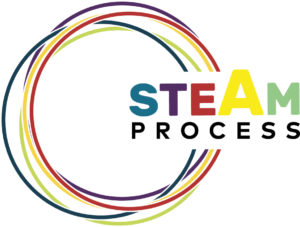![]()
STEAM Process is an Erasmus+ project and has the ambition to foster disruptive innovation for research and science.
The project promotes the use of artistic soft skills in science/tech education and practice. In particular, the project wants to:
- Encourage programmes for skills development and lifelong learning to include a clear component for culture and creativity. It is crucial to assess the actual use and impact of the projects funded in the frame of programmes, such as Erasmus+, that are promoting the transition from STEM to STEAM training.
- Support programmes integrating the arts into STEM curricula as well as cross-sectorial projects blending the arts with STEM disciplines. The studio and the laboratory are learn-by-doing, learn-by-making educational experiences. The iterative process and experimentation are key components to advances and discoveries in both fields. Artists, designers, and scientists alike are utilizing data in new and interesting ways to inform their practices and affect positive change. Productive cross-disciplinary collaborations are being formed in both the academy and in the workplace.
- The development of a Cultural and Creative Sector literacy policy, for example through an own-initiative report or via a pilot project/preparatory action. Such literacy policy would help to stimulate the interest and demand for European cultural diversity, as well as stimulate creative thinking across EU citizens, in particular, focused on specific policy issues. Art school students and graduates are also having a huge impact on social innovation by bringing to light and helping to solve important global issues. Architects and designers have a unique and ethical responsibility to develop, for example, environmentally creative solutions. And artists play an increasingly significant role in addressing societal challenges as many shifts toward work that is collaborative and community-based.
PUBLICATION: INTRODUCING THE (A) IN STEM PROCESSES
The material in this publication was collected from all across the globe in the pursuit of wanting to understand how the arts and science collide. The cases were collected by all our project partners from the different corners of Europe, each bringing their own point of view and understanding of the themes with them.
As we analyzed the case data, we formed the three phases: Insight, Process and Output. This thinking follows a very general model of any project. First, we have the idea, next we plan and create it, and lastly we show the end product. Categorizing these arts and science cases into unique phases helped us to understand what kind of collision exists already between them.
We hope that this publication inspires teachers, artists and scientists to think of what we can all learn from both the arts and science in order to more holistically and meaningfully understand the world we live in. To also appreciate the incredible advances we have made in science, that enable and provide unforeseen tools for artists to make new art and visions for the future. And to let these visions once again inspire scientists to think of how to realize the possible visions of how life could be. And thus, complete the creative process – in order to start another one again and anew.
Read the publication here: STEAMProcess – Introducing the (A) in STEM Processes (xamk.fi)
STEAM METHODOLOGY HANDBOOK
The handbook offers a series of activities dedicated to both artists and scientists: why? Because, following the path indicated by the new movement launched by the President of the European Commission Ursula Von der Leyen, “to build a future that is beautiful, sustainable and inclusive, it is necessary to create a space of encounter situated at the crossroads between art, culture, science and technology”. The complex problems of the contemporary world require complex solutions: combining art and science means stratifying the research processes, and stimulating creativity, innovation and critical thinking.
Read the handbook here: STEAMProcess Methodology Handbook [6.3Mb]
STEAM PROCESS GAME
The STEAM Process game is an educational tool for the training of students and STEM professionals in Artistic Skills, in order to stimulate a STEAM approach to research and design. Download the game set, print and cut the cards and templates, and start playing!
Download the printable game set here: STEAMProcess Game [2.26Mb]
Visit the website to learn more: https://www.xamk.fi/en

